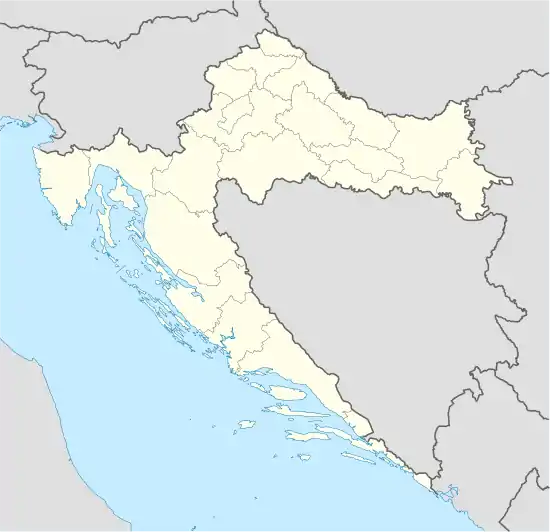Voćin massacre (1942)
The Voćin massacre was the killing of 350 Serb civilians in Voćin, Independent State of Croatia, by the Ustaše Croatian fascist organization on 14 January 1942, during World War Two. The massacre was carried out as retaliation for partisans' action in Papuk.[1]
| Voćin massacre | |
|---|---|
Voćin on the map of Croatia. | |
| Location | Voćin, Independent State of Croatia (today Croatia) |
| Coordinates | 45.619861°N 17.547813°E |
| Date | 14 January 1942 |
| Target | Serb civilians |
Attack type | Summary executions |
| Deaths | 350 |
| Perpetrators | Ustaše |
Background
On 12 January 1942, in a direct fight between the Partisans and the Ustaše, five Ustaše were killed, and two wounded, one of whom died later.[2]
The Partisans withdrew to Papuk, and Ustaše returned to Voćin and waited for reinforcements from Osijek, Belišće and Virovitica.
Massacre
On 13 January, some 300 Ustaše and Domobran soldiers began with plundering and burning Serbian houses. Civilians who tried to escape or provided resistance were killed and all others were arrested and taken to Voćin.
On Serbian New Year, January 14, the biggest slaughter of the innocent population in Slavonia at that time started. Almost all the male inhabitants of the villages Jorgići, Zubovići, Dobrići, Kometnik and Sekulinci were killed.
During the massacre, a total of 350 civilians were killed.
Acts of individual heroism
Savo Bojcic, the only living witness of the massacre, Novosti
In addition to the victims, some managed to save many Serbs from Voćin and its surroundings. The Croat gendarme sergeant Luke Mustafić managed to save the lives of 10 Serbs during the massacre.[3]
Aftermath
On the following day, Ustaše transported Serb corpses to a mass grave that was excavated east of Voćin, along the Voćinka river.
The most significant consequence of this crime was strengthening of the partisan movement in the area of Voćin and Podravska Slatina, exactly the opposite effect of what NDH's authorities tried to achieve.[4] Although during 1941 and early 1942 there were not many local residents in favor of active resistance, due to increasing existential threat, a large number of Serbs from the surrounding villages joined the partisan units.[4]
A memorial to the victims of this massacre was erected in 2007.[5][6]
References
- "Sjećanje na 350 nedužnih žrtava ustaškog terora". Virovitica.net. January 15, 2013.
- "Komemoracija pobijenim srbima voćinskog kraja". Association of Descendants and Supporters of Victims of Complex of Death Camps NDH, Gospić-Jadovno-Pag 1941. January 14, 2013.
- "Sjećanje na pokolj nevinih u Slavoniji". Novosti. Serb National Council. January 21, 2012.
- Škiljan, Filip (2010). "Stradanje Srba, Židova i Roma u virovitičkom i slatinskom kraju tijekom 1941. i početkom 1942. godine". Scrinia Slavonica. Slavonski Brod: Hrvatski institut za povijest - Podružnica za povijest Slavonije, Srijema i Baranje. X, 1: 360-362. ISSN 1848-9109.CS1 maint: ref=harv (link)
- Kovačević, Antonije (January 3, 2017). "USTAŠKE PRETNJE SRBIMA U VOĆINU: Proći ćete kao '43". Ekspres.
- "Bomba na spomen-obeležju žrtvama u Voćinu". mondo. January 14, 2007.
